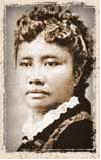|
After
the arrival of Captain Cook there were 8 Hawai’ian rulers.
Kings Kamehameha I, II, III, IV and V, Prince Lunalilo, Monarch
David Kalakaua and Queen Liliuokalani.
Keeping a long
story as short as possible... Over the course of about 100
years, Christian missionaries and U.S. businessmen came to the
islands, loved the beauty and spirit there and then didn’t
want to leave. Many were clever businessmen who gained favor
with the kings, then power and then control.
 In
the early 1800s, foreign commodities merchants dealing primarily
in sugar began exerting greater and greater economic power over
a relatively poor Hawaiian economy run by monarchs. Many
arrangements favorable to the United States and other countries
had been put in place in exchange for opening up trade routes.
Favors granted by King Kalakaua to the United States included
preferential economic deals and the granting of a military base,
Pearl Harbor. Some of these deals, however, were made under
duress. And then it got even worse. In
the early 1800s, foreign commodities merchants dealing primarily
in sugar began exerting greater and greater economic power over
a relatively poor Hawaiian economy run by monarchs. Many
arrangements favorable to the United States and other countries
had been put in place in exchange for opening up trade routes.
Favors granted by King Kalakaua to the United States included
preferential economic deals and the granting of a military base,
Pearl Harbor. Some of these deals, however, were made under
duress. And then it got even worse.
In 1877, a group of 400 American businessmen banded together to
form "The Hawaii League" with the intention of
severely curtailing, if not overthrowing the monarchy. They
forced King Kalakaua to sign a revised Hawaiian constitution
which sharply cut his powers. This document is known as
"The Bayonet Constitution" -- a document never put to
a vote before the 400,000 Hawaiian people, who were said to
strongly oppose its principles.
 When
Queen Liliuokalani was crowned in 1891 after the death of King
Kalakaua, she intended to proclaim a new constitution which she
had written herself, rescinding the Bayonet Constitution and
restoring power to the throne and rights to the native Hawaiian
people. But American missionary Lorrin Thurston and his
Annexation Club were behind the scenes, plotting the overthrow
of the queen and Hawai'i's annexation to the United States. In
January, 1893, he and his cohorts succeeded, with the good-will
wishes of President Benjamin Harrison and 163
strategically-placed American troops. When
Queen Liliuokalani was crowned in 1891 after the death of King
Kalakaua, she intended to proclaim a new constitution which she
had written herself, rescinding the Bayonet Constitution and
restoring power to the throne and rights to the native Hawaiian
people. But American missionary Lorrin Thurston and his
Annexation Club were behind the scenes, plotting the overthrow
of the queen and Hawai'i's annexation to the United States. In
January, 1893, he and his cohorts succeeded, with the good-will
wishes of President Benjamin Harrison and 163
strategically-placed American troops.
Sanford B.
Dole was appointed as president of the republic's government in
1894. Although President Grover Cleveland denounced the coup in
the mid 1890s and tried to have the decision reversed, Congress
overruled him and signed the annexation agreement in 1898.
There is another
side to this story. The Americans asserted all along that they
were working in the best economic interests of the Hawaiian
people; that the trade agreements they brought to their country
allowed the Hawaiians to become more stable and prosperous. The
Americans felt that the dissembling Hawaiian monarchs were
incapable of ruling a country by then-modern standards and
leading it into the 20th century. Missionary Lorrin Thurston
felt he was doing the right thing by pushing to raise the
standards of people he considered, by his estimation, to be
uneducated heathens. In all their arrogance and focus on their
own self interests, they didn't bother to consider that these
decisions were not legally theirs to make.
The Hawaiian people are lobbying hard to get their land back,
which is now almost wholly owned by the Japanese and
non-Hawaiian Americans. Native Hawaiians are finally coming to
grips with the negative cumulative impact that colonization,
World War II and commercial exploitation has had on their
country and culture.
One hundred years
after the over-throw and take-over, President Clinton made a
formal apology to the Hawai’ians in 1993 for the shameful
events of 1893 and 1898. But we doubt that America will ever
concede the state back to its people.
Prior to the
Bayonet Constitution, no one in Hawai’i “owned” land.
Basically, all the land belonged to the Hawai’ian kingdom
& people. After the laws were passed and the kingdom was
over-thrown, foreigners ended up owning over 70% of the
Hawai’ian Islands (the state was given 30%), leaving the
native Hawai’ian people with less than 1% of their own land.
Many became too poor to support themselves. Today 70% of the
land in Hawaii is still owned by only 50 individuals or entities.
The natural
resources that blessed Hawai'i were ultimately her downfall. But
fortunately for everyone, her cultural riches are just as great.
Although the country may no longer be their own, the wonderful
Hawaiian culture cannot be taken away from its native people,
who still are gracious enough to share it with the rest of the
world.
Taken from "How
The Hawaiians Lost Their Country" by Rusty DeSoto
Back
|